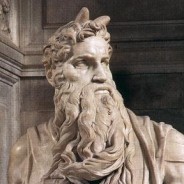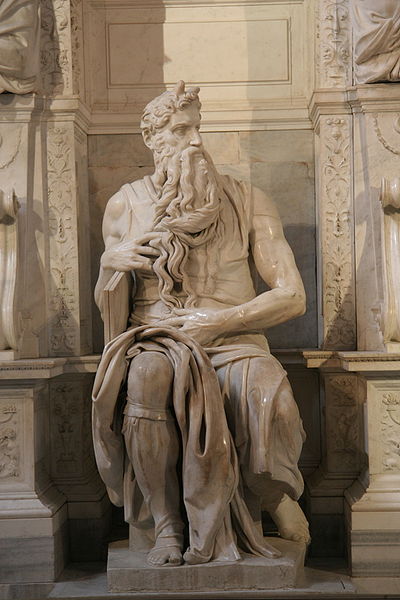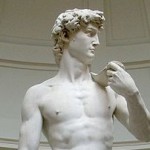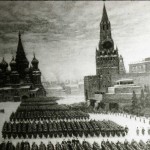Why did Michelangelo sculpt Moses with horns?

Why did Michelangelo sculpt Moses with horns?
Nov 12
Pope Julius II, famous to modern TV viewers as the Cardinal della Rovere on the popular miniseries The Borgias on Showtime or as the frustrated Pope in the 1965 movie The Agony and The Ecstasy (played by Rex Harrison) who constantly questions of Michelangelo when will he make an end of the painting of the Sistine Chapel, commissioned the sculpting of Moses to adorn his tomb. Today this statue can be found at the Basilica of San Pietro in Vincoli where Julius is interred. Incidentally, the Sistine Chapel, for which Julius engaged Michelangelo to paint the remarkable ceiling, was built by the other della Rovere Pope, Sixtus IV, Julius’ uncle, and is named in his honor. The Basilica is the family church of the della Rovere.
It’s easy to say that this is a popular, but ridiculously common, misconception about Jews in general. Jews were demonized in Medieval times (and throughout the ages) and were often described as having demonic features such as hooves, horns and tails. This horrid belief has traveled down to our supposedly modern, sophisticated, and better educated times. For example, the father of a friend of mine was on a business trip to West Virginia in the 1950’s, when it was common for men to wear hats outside. He noticed that he was being followed all around by the townsfolk. He thought this was curious behavior and decided to ask his hosts about this. He was told that the townsfolk had never seen a Jew before and they were hoping to see him take off his hat that they might get a glimpse of his horns.
While demonizing Jews as “Christ Killers” has been endemic to anti-semites for centuries, the horns sculpted by Michelangelo, and the misconception by many small minded people, have a much more simple explanation.
In Exodus, Chapter 34 Verses 29 to 35 read in modern translations:
29 As Moses descended from Mount Sinai-with the two tablets of the testimony in his hands as he descended the mountain-he did not realize that the skin of his face shone as a result of his speaking with the Lord. 30 When Aaron and all the Israelites saw Moses, the skin of his face shone! They were afraid to come near him. 31 But Moses called out to them, so Aaron and all the leaders of the community returned to him, and Moses spoke to them. 32 Afterwards all the Israelites came near, and he commanded them everything the Lord had told him on Mount Sinai. 33 When Moses had finished speaking with them, he put a veil over his face. 34 But whenever Moses went before the Lord to speak with Him, he would remove the veil until he came out. After he came out, he would tell the Israelites what he had been commanded, 35 and the Israelites would see that Moses’ face was radiant. Then Moses would put the veil over his face again until he went to speak with the Lord.
However, in the Vetus Latina, a translation by St. Jerome in the 4th Century CE (Common Era, the Jewish way of referring to AD, or Anno Domini, In the Year of The Lord, or After Christ), and chosen by the Roman Catholic Church as the official translation, reads as:
29 And when Moses came down from the Mount Sinai, he held the two tables of the testimony, and he knew not that his face was horned from the conversation of the Lord. 30 And Aaron and the children of Israel seeing the face of Moses horned, were afraid to come near. 31 And being called by him, they returned, both Aaron and the rulers of the congregation. And after that he spoke to them, 32 And all the children of Israel came to him: and he gave them in commandment all that he had heard of the Lord on Mount Sinai. 33 And having done speaking, he put a veil upon his face. 34 But when he went in to the Lord, and spoke with him, he took it away until he came forth, and then he spoke to the children of Israel all things that had been commanded him. 35 And they saw that the face of Moses when he came out was horned, but he covered his face again, if at any time he spoke to them.
How can there be such a massive difference in interpretation which basically hinges on the translation of a single word? The word causing all the trouble is קרן or kuf resh nun. You might ask how is that word pronounced?, and that’s the source of the problem.
It’s important to understand that Hebrew, the oldest continuously spoken language in the world, has been written since ancient times only with consonants. The oldest known examples of written Hebrew date back to the 10th century BCE (Before the Common Era, the Jewish way of referring to BC, Before Christ), the time of the 2nd Jewish temple in Jerusalem. It’s not clear exactly when nikkudote, or the symbols for vowels, were developed. What is clear is that the nikkudote were made as small dots, dashes, or points, so that they could be inserted into existing Hebrew texts where the author never anticipated the need to add vowels. Again, why does this matter and how does this lead to Michelangelo sculpting Moses with horns?
Well, how should a series of consonants be pronounced? For example, if I give you the English consonants “RM” do I mean room? Or roam? What about ROM? Or ram? What about Rapid Eye Movement, REM? Or did you want a drink of rum? Another example goes to the name of God. We know that the consonants of God’s name are Yud He Vav He, but what are the vowels? That’s why we have such varying pronunciations as Yahweh and Jehovah.
So what Hebrew words can we make from the consonants kuf resh nun? Well, by now you’ve guessed that one of the possible words is horns. But it is also possible to find the words ray, beam, radiate, and shine. It seems illogical to me that contextually the word was meant to be horns, but St. Jerome interpreted it thus. I think it was more likely that what is meant, in modern terms, is that a halo radiated around Moses’ head. We represent saints and holy people as having a halo. Why would Moses, the most important prophet of the Old Testament, and one of the few people we believe to have talked directly with God, not have a halo?
One last thought, if St. Jerome believed that Moses had grown horns because of his conversation with God, surely such a holy source would be a positive and not a symbol of demon worship. But one mistaken interpretation has led to millennia of a further misinterpretation.







